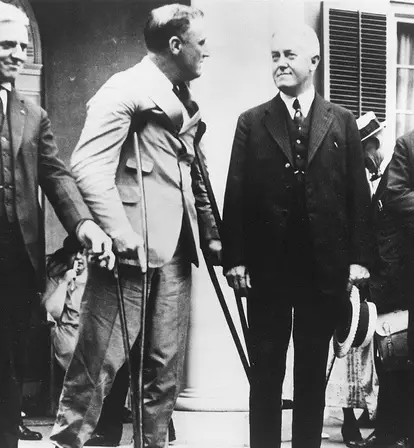As FDR's New Deal worried Wall Street, a cadre of bankers decided to replace him with decorated Marine Corps General Smedley Butler as their fascist dictator. Here's how they failed.
On Nov. 24, 1934, retired General Smedley Butler sat before a closed session of the Congressional Special Committee on Un-American Activities in New York. Though he was a two-time Medal of Honor winner with a once unimpeachable reputation, Butler knew there were already those outlets, like the New York Times, who would call his story a “Gigantic Hoax.”
He also knew, however, that if he said nothing the Business plot, a coup of the country’s most wealthy designed to remove President Franklin D. Roosevelt from office and replace him with a fascist regime, could only continue. Worse still, it might succeed.
“May I preface my remarks by saying, sir,” Butler began, “That I have one interest in all of this, and that is to try to do my best to see that a democracy is maintained in this country.”
Smedley’s testimony was ultimately dismissed. The conspirators were never prosecuted.
Smedley Butler: An Uncommon Marine
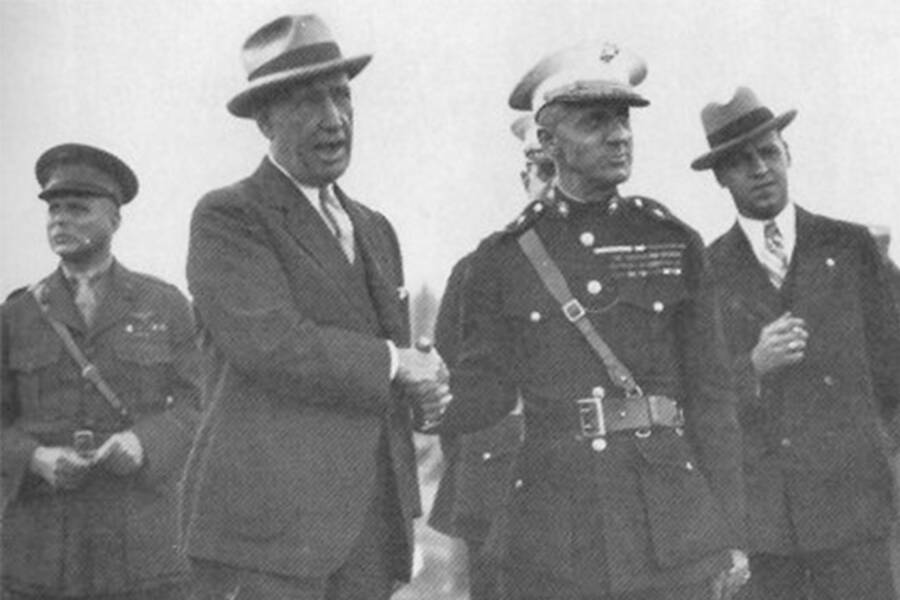
Wikimedia CommonsSmedley Butler at his 1931 retirement ceremony.
Born to a Quaker family in 1881 Pennsylvania, Smedley Butler would rise from an underaged 16-year-old soldier in Cuba to one of the most well-respected military men in the United States.
Butler rose to Major General in the Marine Corps through his service in the Boxer Rebellion and across Central America before accepting his commission in the First World War.
As the commander of a fort in northern France, Butler oversaw the care of more than two million men and earned a reputation as someone who understood the common man. Following the Armistice in 1918, he had accepted command at a Marine Corps base in Quantico, Virginia and waded into politics and criticism of President Hoover. Naturally, the president grew to dislike Butler.
Butler finally retired in 1931 when the president snubbed him by giving the role of Commandant of the Marine Corps to a less senior officer.
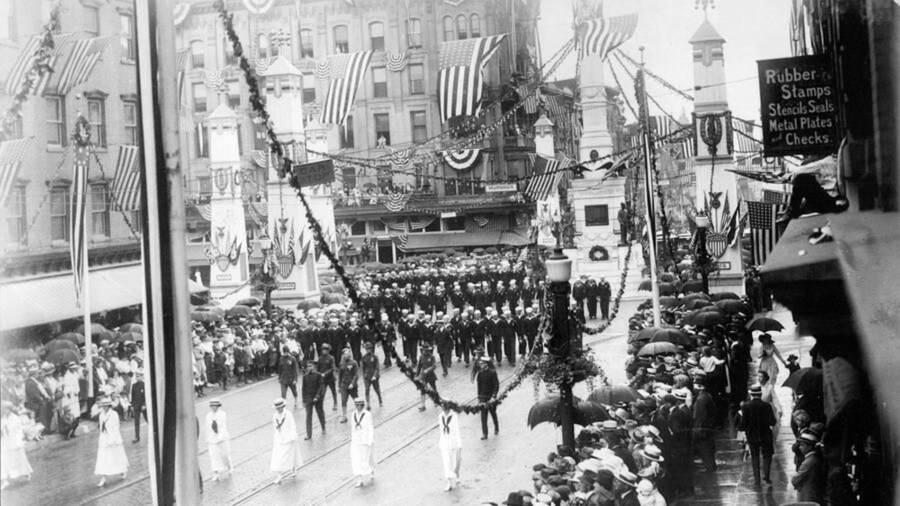
Wikimedia CommonsVictory parade celebrating the end of World War I. 1919.
It was just as well, by this time, Hoover’s presidency was riddled with problems.
At the end of World War I, more than three million American troops had returned from “the war to end all wars” in various states of disarray. The veterans were without support in an era before the official recognition of post-traumatic stress disorder, the Veterans Affairs Bureau, or anything resembling a GI bill.
In 1919, most veterans had received $60 in mustering pay and a train ticket home for their trouble. The American Legion organization was consequently established to serve as a veterans’ union to increase their bargaining power in government and petition for aid.
In 1924, these efforts resulted in the passage of the War Adjusted Compensation Act, which promised World War I veterans bonus pay for their lost wages in the form of a bond that would be collectible after 20 years in 1945.
This had seemed like a reasonable compromise at first. But then, the stock market crashed in 1929.
The Battles Of The Bonus Army

Bettmann/Getty Images; Ryan StennesOne of the shanty towns, or “Hoovervilles,” in Central Park at the height of the Great Depression. 1933.
By 1932, “Hoovervilles” or tent cities for the homeless and downtrodden, were a common sight across the country.
When, however, a camp of around 15,000 veterans who called themselves “The Bonus Army” formed outside of Washington D.C., officials and politicians began to panic.
Backed by some U.S. politicians, the Bonus Army demanded immediate payment of their bond debts to assist their families and boost the economy. In total, this would have required more than two billion dollars, roughly half the Government’s budget for the year.
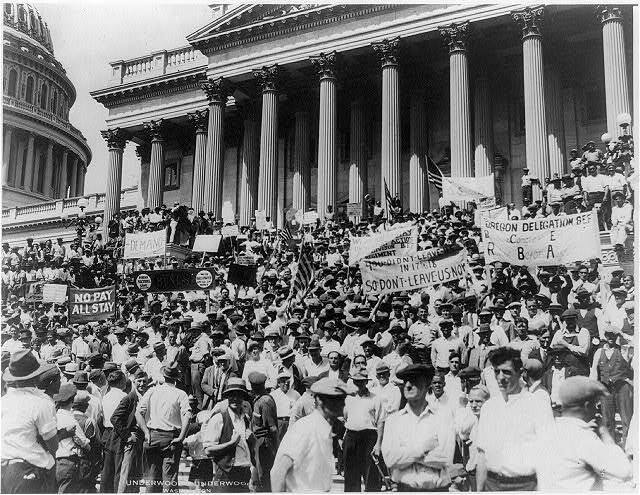
Library of CongressThe Bonus Army protests in 1932 outside the Capitol for the wages they were promised before the Great Depression hit.
While President Herbert Hoover and his military advisors argued about what to do with this crowd, Smedley Butler — a newly private citizen making his living as a public speaker — gave a well-received broadcast from the Bonus Army camp.
“They may be calling you tramps now,” Butler declared, “but in 1917 they didn’t call you bums! … You are the best-behaved group of men in this country today. I consider it an honor to be asked to speak to you.”
Butler added that this gathering was “the greatest demonstration of Americanism that we’ve ever had” and urged the soldiers to remain orderly while preserving the country’s faith in its veterans.
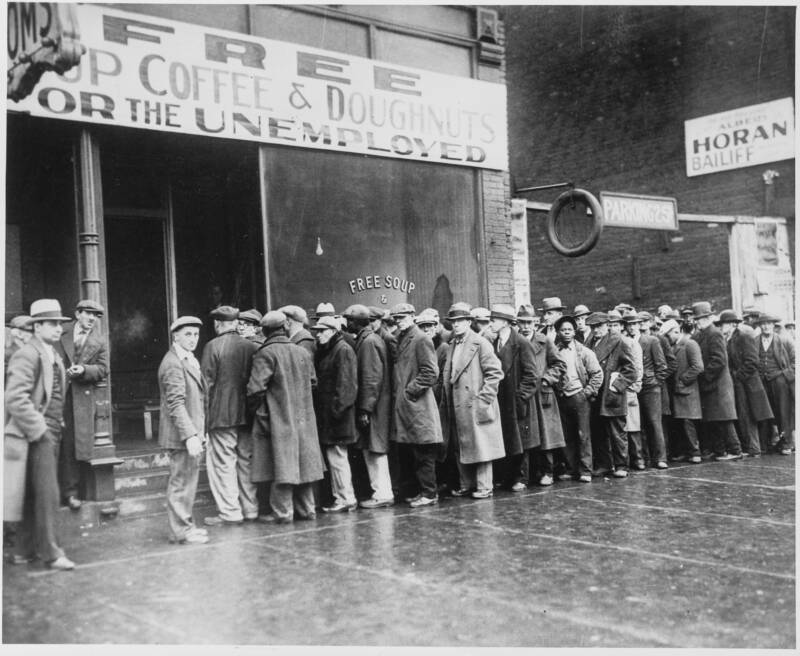
Wikimedia CommonsLine outside Chicago soup kitchen run by Al Capone. 1931.
Butler’s remarks made quite a contrast when, a few days later, Gen. Douglas McArthur and a cadre of armed troops broke up the camp.
Veterans and their families were chased from Washington with gas weaponry and bayonets as their tents were trampled and burned. At least two veterans died and many others were injured.
Angered by the Government’s “betrayal” of its troops, Butler publicly backed Franklin Delano Roosevelt for that November’s election to end Hoover’s presidency.
Butler’s principled stance and bombastic entrance into public consciousness caught America’s attention.

Wikimedia CommonsBonus Army members clash with Washington, D.C. police. 1933.
But it also caught the attention of a covert group of wealthy men who were particularly anxious about these tumultuous times.
A New Deal Threatens The Livelihoods Of The Rich
As part of his New Deal Platform, Roosevelt promised “bold persistent experimentation” to craft a country that worked for all Americans.
In mid-1933, this included taking the United States off the gold standard. The decision led Lewis Douglas, Roosevelt’s budget director, to resign in protest. Douglas called the decision “the end of western civilization” and a good number of people agreed with him.
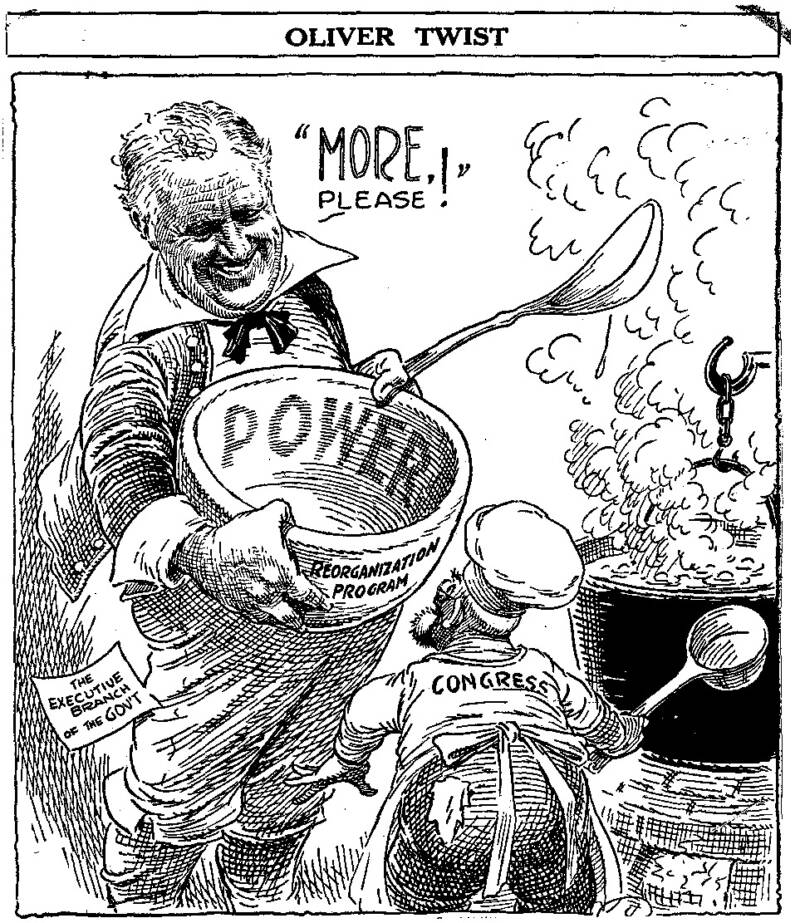
Wikimedia CommonsContemporary political cartoon about Roosevelt consolidating power.
FDR was also relatively unpopular with the wealthy. His plans to employ the unemployed and open opportunity to all, intimidated conservative businessmen.
“Roosevelt was damned as a socialist or Communist out to destroy private enterprise by sapping the gold backing of wealth in order to subsidize the poor,” wrote Jules Archer in his biography, The Plot to Seize the White House: The Shocking True Story of the Conspiracy to Overthrow FDR.
By this time, Butler had become accustomed to living as a public speaker and hired particularly to speak with veterans. So, when a mutual friend called to say two members of the American Legion wanted to meet with him, he was not too surprised.
But when, on July 1, 1933, these men — Gerald MacGuire and Bill Doyle — arrived in a chauffeured limousine, Butler grew suspicious about who exactly these “wounded veterans” worked for.
Butler’s First Intro To The Business Plot
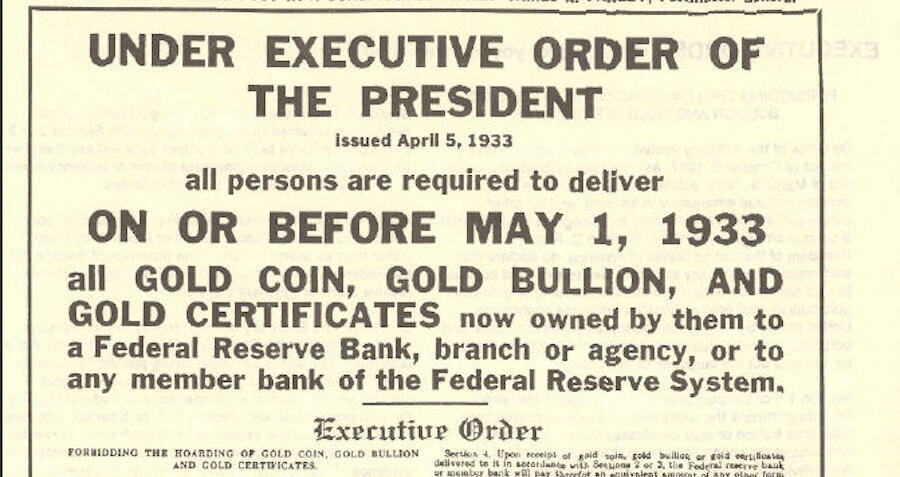
Wikimedia CommonsAnnouncement of Executive Order forbidding private gold ownership, part of Roosevelt’s economic policies.
The following information regarding Butler’s meetings with the men behind the Business Plot was obtained in his 1933 testimony on the matter.
According to Butler, over several visits, MacGuire – a World War I soldier-turned-banker — asked him if he would be interested in taking over the leadership of the American Legion at the upcoming convention that September.
Butler pointed out that he hadn’t been invited, but MacGuire said he was on the delegation committee and could have him brought in as a special guest from Hawaii.
After Butler declined, the banker offered some 300 to 400 men to disrupt the convention and demand that the general take the stage.
Butler was startled by this offer, but he decided to play along. He said wasn’t sure what he would say, or how so many struggling veterans were supposed to get to Chicago. MacGuire said his organization, the Committee for Sound Currency, had already written him a speech and produced bank statements for over $110,000, which is just under two million by today’s standards, “for expenses.”
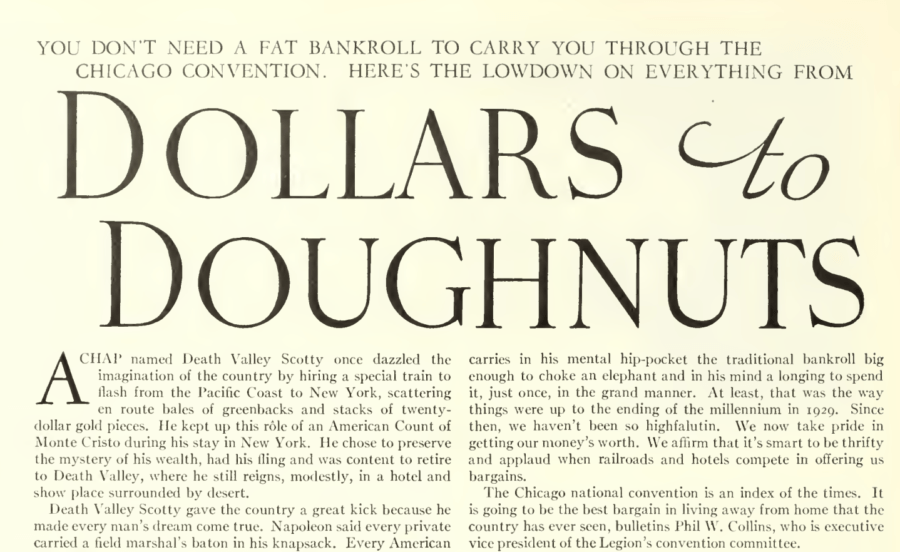
American Legion Digital ArchivesExcerpt from American Legion guide article to 1933 convention. October 1933.
After Butler read the speech, he asked who had written it and why a speech about soldier’s bonuses focused so much on returning to the Gold Standard.
The banker answered that it had been written by John W. Davis, who was 1924’s Democratic Presidential Candidate, former Ambassador to the U.K., and current legal counsel to J.P. Morgan and Company.
Davis, MacGuire continued, was an associate of his direct employer who was also a soldier, financier Colonel M.P. Murphy. The “why,” MacGuire said, was very simple. They just wanted to make sure that the veterans received their bonuses with real, not “rubber” money.
MacGuire offered Butler checks from Murphy and another man named Robert S. Clark as a down payment to help get the necessary gang together.
Butler knew both of these men from back in the Boxer Rebellion. He also knew that Murphy was a multi-millionaire and had been one of the biggest backers of the American Legion’s founding, fronting $125,000 — so why would one of the Legion’s founders want him to overthrow their leadership?
Robert Clark’s Offer
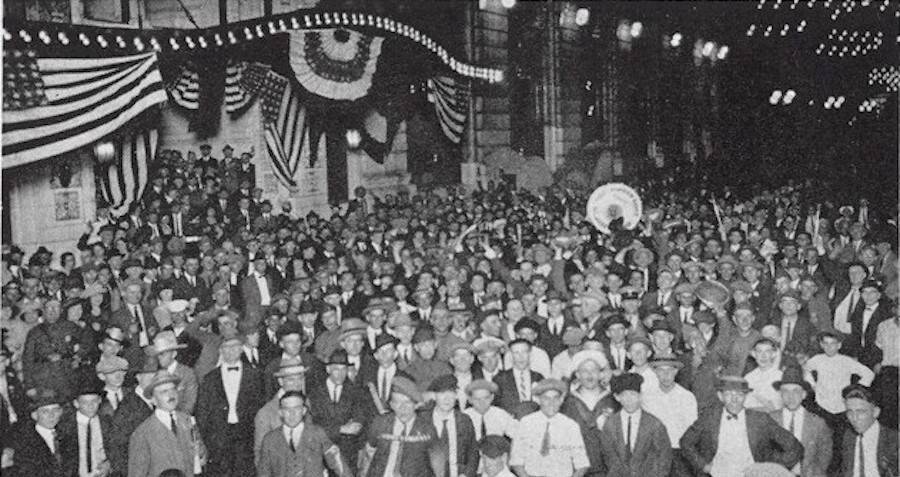
Wikimedia CommonsAmerican Legion Convention, 1922.
Robert S. Clark had served under Butler in China known as the “millionaire lieutenant,” a young heir to the Singer Sewing Machine fortune. Now, he was a settled and successful financier.
When in New Jersey for a speaking engagement, MacGuire surprised Butler at his hotel to once again ask about gathering soldiers and giving a speech.
Butler, frustrated, said he didn’t believe that MacGuire actually had the money. The banker pulled $18,000 in thousand-dollar bills from his wallet and threw them onto Butler’s bed. Insulted, Butler said he was tired of dealing with middlemen. He demanded to speak with Robert Clark himself.
MacGuire agreed.
Just before the American Legion Convention in Miami that September, Clark traveled by train to his old commander’s home. The pair caught up, reminisced about the Boxer Rebellion, and then got down to business.
Clark reiterated the same pitch about gathering soldiers and getting back to the Gold Standard. Butler said it didn’t add up. Finally, the former officer came clean.
According to Butler, Clark told him that he had a fortune of $30 million. These were uncertain times, and if he had to spend half of his money to protect the other half, he would do it.
All of his partners would do this too, even if that meant paying the bonuses for every soldier themselves.

Getty ImagesGerald MacGuire, his attorney N.L. Marks, and William MacGuire.
Roosevelt was on the verge of destroying everything with his inflation and overspending, Clark claimed. If Butler gave the speech and took control of the Legion, demanded a return to the gold standard, then perhaps they could persuade congress and the president to do so as well.
Butler’s Last Stand
Butler asked how Clark could be so sure that Roosevelt would abandon his own political platform.
Clark said that was simple. Roosevelt was from a rich family. He swam in the same circles as the conspirators. The president would have the backing of some very powerful friends, and so would Butler if he played along.
The retired general said he didn’t like seeing soldiers used as pawns to undermine democracy. Clark told him to stop being so stubborn and offered to pay his mortgage.
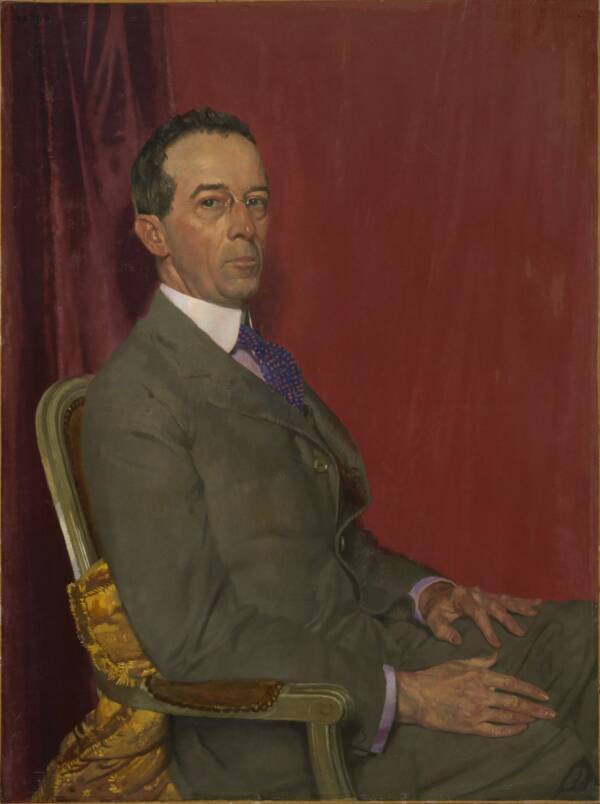
Wikimedia CommonsRobert S. Clark, heir to the Singer Sewing fortune, horse breeder, and philanthropist — and a conspirator in the plot to overthrow FDR.
Furious, Butler took his guest down the hall to his study. He pointed around the room, indicating all the medals and honors he had been awarded in his career. Clark, seemingly sobered by the sentiment, asked to use the General’s phone.
Once MacGuire answered, Clark told him that Butler would not be joining them in Chicago and they should proceed with Plan B. The only other part Butler heard was “telegrams.”
Reading about the convention after the fact, Butler was horrified to discover that telegrammed pamphlets had fallen from the ceiling during. In them, a message argued for paying bonuses and returning to the gold standard.
They had inspired the Legionnaire’s to officially support gold-backed currency.
In October, MacGuire visited Butler again. The general was about to embark on a nationwide speaking tour on behalf of the Veterans of Foreign Wars. MacGuire bragged about the convention resolution, but Butler replied that the soldiers were no closer to their bonuses.
The banker offered to pay Butler $750 for every speech he mentioned the gold standard in, but Butler refused.
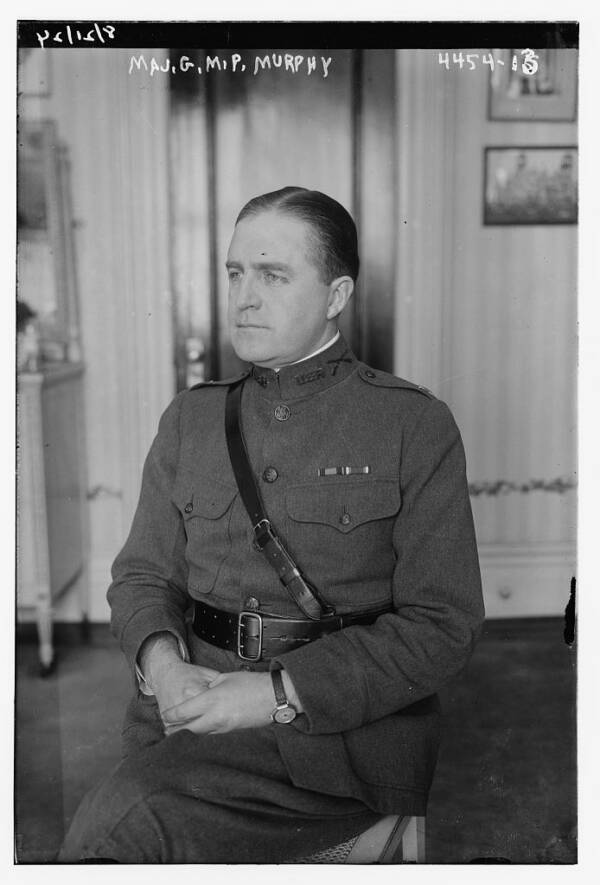
Wikimedia CommonsGrayson Mallet-Prevost Murphy, or Colonel M.P. Murphy of the Business Plot, in 1918.
MacGuire asked that he be allowed to come on the tour to recruit men. Again, Butler said no.
The Fascist Plot Revealed
He did not hear from MacGuire again until January. Then, he started receiving postcards from all over Europe.
The messages described a “family vacation” in Italy, the French Riviera, and Berlin. That summer, when Butler’s tour was finished, MacGuire asked to meet him again.
On Aug. 22, 1934, three days after Hitler officially became the Führer of Germany, Butler met MacGuire seated at a secluded table at his hotel restaurant.
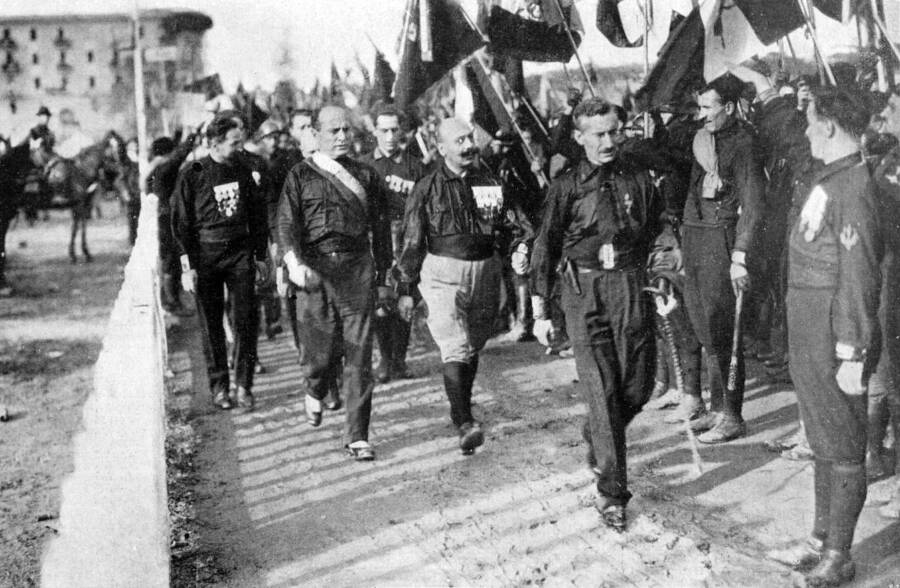
Wikimedia CommonsMussolini marches with Blackshirts in Rome. 1922.
MacGuire started talking about getting soldiers together but then started talking obsessively about his travels. Butler kept waiting for him to get to the point but then he picked up on the pattern within the anecdotes.
In France, MacGuire had met with members of the Far-Right paramilitary veterans group, La Croix de Feu or “The Cross of Fire.” In Italy, he had studied the structure of Mussolini’s government and been enamored of the loyalty and power of Il Duce’s Black Shirts.
He’d also met with representatives of the new German government and admired their ambitions.
The time was right to try the same thing in America, MacGuire said. A new Secretary of General Affairs, one who would replace the Secretary of State and leave the President to “dedicate bridges and kiss children.”
For the first time, Butler understood what MacGuire wanted. MacGuire and his group wanted Smedley Butler to become America’s first fascist dictator, propped up by a devoted following of veterans.
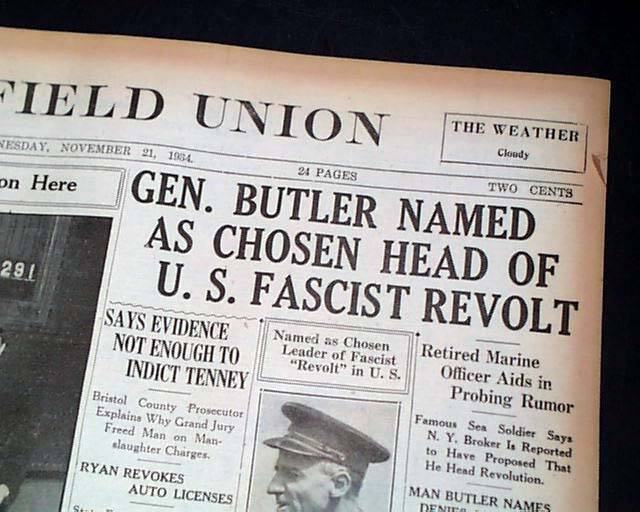
The Times-Picayune, 1934.Butler’s claims made it to the front page of the Springfield Union, and various other papers.
Some members of his organization, MacGuire said, had wanted Douglas MacArthur to lead the revolution. But, he’d known since the break-up of the Bonus Army that MacArthur would never be as esteemed as Smedley Butler would be to the veterans.
MacGuire estimated that in all, they’d only need an army of about 500,000.
The general asked how they intended to pull all this off or even pay for it. MacGuire explained that the group would be announcing its presence publicly in the next few weeks. He wasn’t sure which name they’d settled on yet, but between the collaborators, they might have as much as $300 million to commit to “protecting the constitution.”
That is more than $5 billion in 2019 currency.
Whether Butler agreed or not, MacGuire said, once they got in touch with the right members of the American Legion and Veterans of Foreign wars and acquired weaponry, it was only a matter to time until their plot was successful. Once again, he asked Butler to think about it.
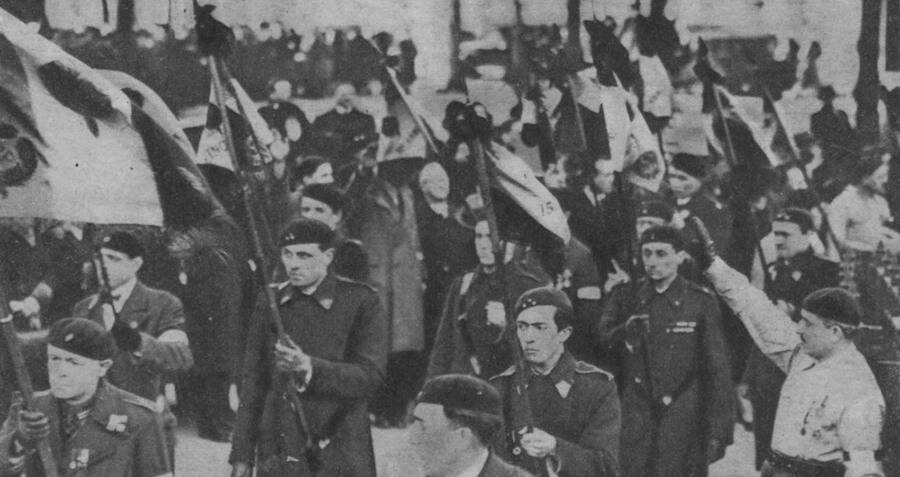
Wikimedia CommonsFrench Fascists march in Paris. 1934.
This time, Butler couldn’t stop thinking about it. Mussolini had proved strangely popular in the American media over the last decade. The press was similarly hopeful about Hitler.
In July, Fortune Magazine had run an editorial which asked “whether Fascism is achieving in a few years of decades such a conquest of the spirit of man as Christianity achieved only in ten centuries.”
The article went on, “the good journalist must recognize in Fascism certain ancient virtues of the race, whether or not they happen to be momentarily fashionable in his own country. Among these are Discipline, Duty, Courage, Glory, Sacrifice.”
Butler decided to call a friend at the VFW and warn him about what he’d been hearing. As it turned out, there were other, similar rumors floating around.
Without proof, the conspiracy was not necessarily anything more than just a rumor.
The Conspirators Make Their Move
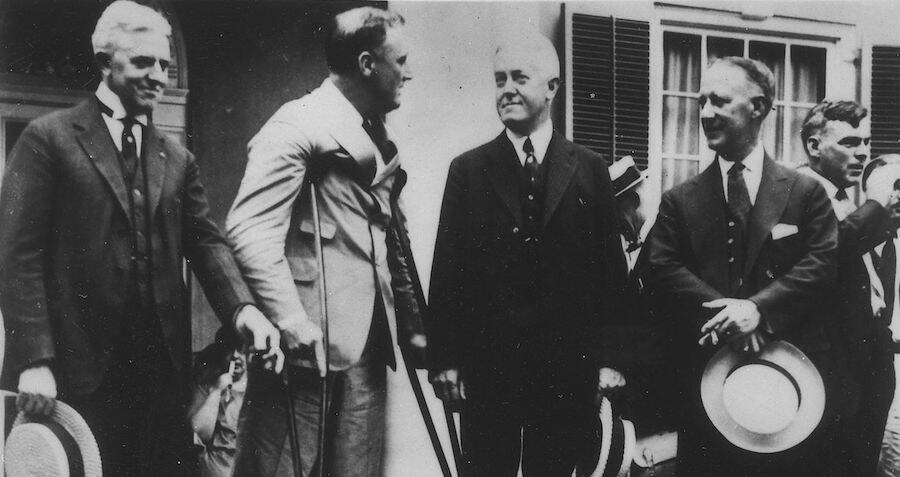
Wikimedia CommonsFDR (second from left) with accused conspirators John W. Davis (second from right) and Al Smith (right). 1924.
When the American Liberty League (ALL), a group of conservatives who opposed FDR and his New Deal, became public, any notion that it was merely a rumor was abolished.
Among its members were Colonel M.P. Murphy, Robert S. Clark, and John W. Davis — every one of the conspirators MacGuire had mentioned.
There were other connections too. The members’ list of the American Liberty League was a who’s who of business and politics including members of both political parties opposed to the New Deal. Its stated purpose was to “protect the constitution.”
Butler realized something else, then, about himself.
Part of why he’d been the perfect candidate was that he was known for his temper and speaking out. If he went public with his accusations, people might think it was a publicity stunt. He needed more than his own word to inform the government.
So, he reached out to a journalist from the Philadelphia Record, Paul French, who agreed to help him collect evidence.

Wikimedia CommonsPaul French of the Philadelphia Record, to whom Smedley Butler broke the story of the Business Plot.
French determined that ALL member Irenee Dupont, who would later do business with the Nazis well into World War II, owned a controlling stake in Remington-Colt which possibly provided the group with access to artillery.
Other members of ALL included Al Smith, former governor of New York and 1932 democratic presidential hopeful and turned rival of President Roosevelt; as well as other men whose connections ran back to the Klu Klux Klan and Pro-Nazi groups within the United States.
As the New York Post put it, “The brood of anti-New Deal organizations spawned by the Liberty League are in turn spawning Fascism.”
Collecting The Evidence And Exposing The Truth
To build more evidence, Butler introduced French to MacGuire as a like-minded friend. Soon, MacGuire opened up to the reporter as well, in some cases being even more candid with French than he had been with the general.

Getty ImagesGerald P. MacGuire was subpoenaed by the Congressional Committee On Un-American Activities. Here he is in court.
According to French’s account, MacGuire was convinced that “We need a Fascist government in this country…to save the Nation from the communists who want to tear it down and wreck all that we have built — in America. The only men who have the patriotism to do it are the soldiers and Smedley Butler is the ideal leader.”
As French recalled, MacGuire continually discussed “a dictator who would come galloping in on his white horse… either through the threat of armed force or the delegation of power and the use of a group of organized veterans, to save the capitalistic system.”
And it was at around the time that French and Butler were building a case against MacGuire and his purported co-conspirators that the general was subpoenaed to discuss rumors of a fascist plot before Special Committee on Un-American Activities.
After Butler and French had testified, Gerald MacGuire was allowed to speak in his own defense.

The New York Times, 1934.The New York Times headline on Butler’s hearing.
For his part, MacGuire claimed Butler and French had made it all up. He had traveled to Europe for pleasure and had certainly never tried to buy Butler’s compliance in a coup.
Despite this, when letters which contained MacGuire discussing Croix de Feu training movements and plans were produced, he had no explanation for why he so closely described a far-right paramilitary veterans group.
Similarly, he had no explanation for $20,000 that went missing from his accounts during the same time frame that Butler claimed he’d been offered 18 $1,000 bills.
In the end, only MacGuire spoke to the committee. Robert S. Clark lived in France and could not be forced to appear in the United States. But no explanations were provided for the absence of Colonel Murphy, John W. Davis, or any of the other suspected conspirators.
They were never asked to testify at all.
Accusations Of A Government Cover-Up
When the court report was published, it concluded that a plot to overthrow the Roosevelt Administration and install a Fascist government in its place did indeed exist. How far it had gotten was never determined, however, and the investigations into the plot never officially looked into that anyway.
The names of the accused and the American Liberty League, itself, were redacted.
Amidst accusations from The New York Times that his story was “credulity unlimited,” Butler broke his silence once again. In a speech broadcast for radio and recorded for a newsreel, Butler repeated his accusations and openly asked why the named individuals were never called to testify.
Then, on March 25, 1935, Gerald MacGuire suddenly died of “pneumonia” at 37. His family publicly blamed the stress of Butler’s accusations for ending his life.
Regardless of the reasons, with MacGuire gone, the case went cold.
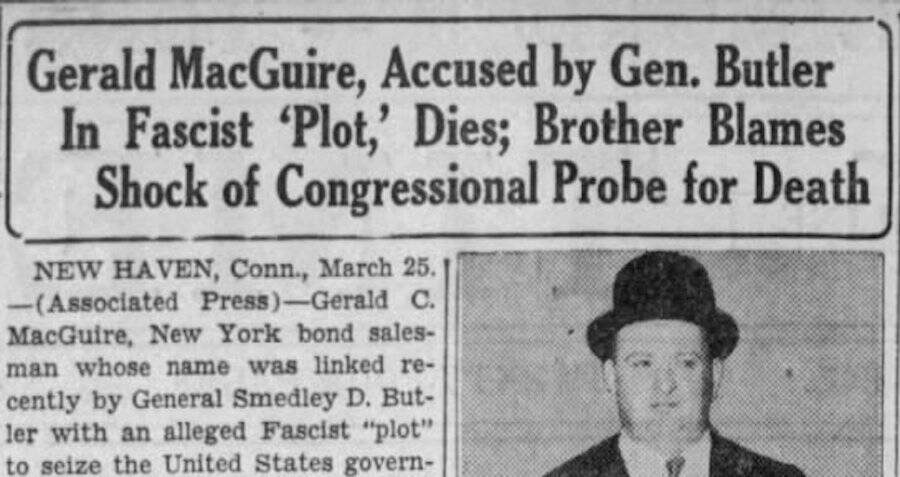
Newspapers.comIowa Dispatch coverage of MacGuire’s sudden death in March 1935.
Butler went on to publish his book War is a Racket later that same year. As an anti-War classic, throughout the text, Butler laments his military roles in places like Nicaragua, Mexico, and China.
“I spent most of my time as a high-class muscle man for Big Business, for Wall Street and the bankers. In short, I was a racketeer, a gangster for capitalism.”
Butler spent the rest of his life trying to draw attention to the ties between big business and the American military. A strident isolationist is his last years, Butler died of pancreatic cancer in June 1940. He was 58.
Alternate Explanations For The Business Plot?
In the decades since, doubters have asked why, if the scheme was real, didn’t President Roosevelt aggressively pursue it?
Would it have been wise for the president to allow a group of openly treasonous fascist sympathizers to continue to operate in Washington? On the other hand, if there was such a group, what could Roosevelt have done about it anyway?
Perhaps the best explanation on the matter to come from Roosevelt came in 1936 when he reaccepted the nomination of the Democratic Party.
Speaking just after he defeated American Liberty League-backed rivals, Roosevelt declared:
“For out of this modern civilization economic royalists carved new dynasties. New kingdoms were built upon concentration of control over material things. Through new uses of corporations, banks, and securities, new machinery of industry and agriculture, of labor and capital — all undreamed of by the fathers — the whole structure of modern life was impressed into this royal service…It was natural and perhaps human that the privileged princes of these new economic dynasties, thirsting for power, reached out for control over Government itself. They created a new despotism and wrapped it in the robes of legal sanction. In its service, new mercenaries sought to regiment the people, their labor, and their property. And as a result of the average man once more confronts the problem that faced the Minute Man.”
Those accused represented the single most powerful subset of American society: the rich.
Within a decade, the alliances between business and government proved vital in World War II. After defeating the American Liberty League in 1936, the organization faded away, apparently peacefully by 1940.
But if MacGuire was more cautious or someone else was asked to ride the “white horse,” could the whole 20th century have been different? Could the United States have entered World War II as a fascist dictatorship?
The frightening reality here is that perhaps the only thing that prevented this was a retired Marine playing Paul Revere.
Next, read up on the death of Fascist dictator Benito Mussolini. Then, see what life was like inside fascist Italy.
